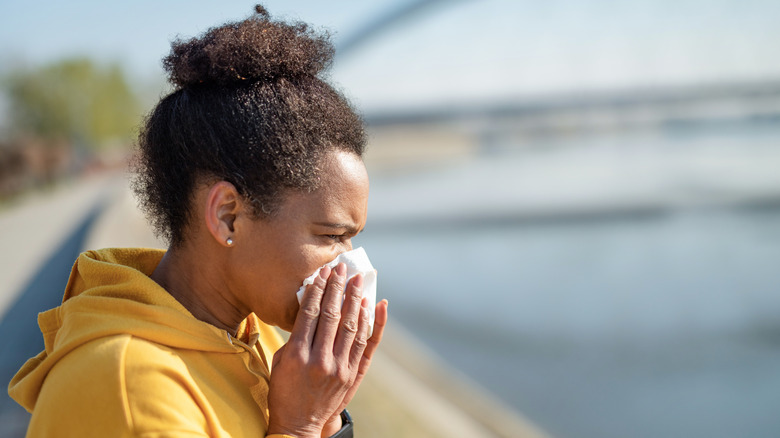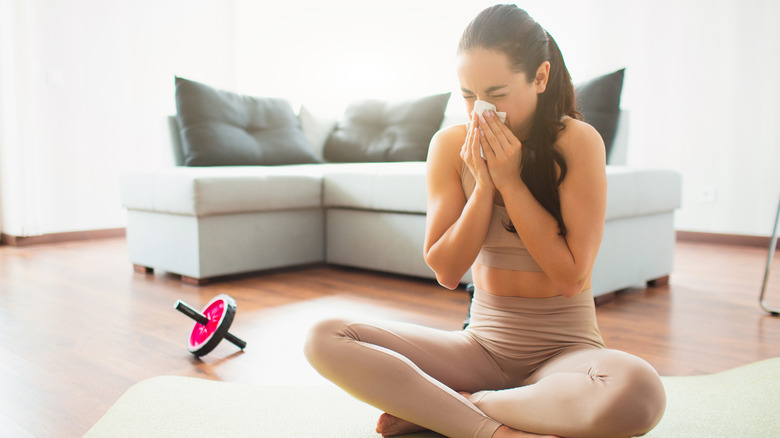Is It Ever A Good Idea To Work Out When Sick? Here's What To Know
Consistency is essential for achieving your workout goals, but overall health means more than just achieving gains in the gym. It's also important to know when to take a break from your fitness routines to give the body time to rest and recuperate.
For serious illnesses that leave you bed-bound, it's a no-brainer to skip your usual workout until you've fully recovered. But for certain instances where your sickness isn't contagious and hasn't left you immobile from weakness, it can be tricky making the choice between skipping your usual run or pushing through the discomfort.
Medical experts have a handy rule for making a decision: If your symptoms occur "above the neck," it's okay to engage in physical activities, albeit at a milder intensity and for a shorter duration. (For example, trading in jogging for the gentler reverse running.) According to a study, although there's little scientific evidence supporting this rule, it's based on the theory that symptoms like an earache or allergies "may be more compatible with exercise," especially when there are no other signs of illness. COVID-19 has naturally made us more wary of particular "above the neck" symptoms, i.e. sore throat and a mild cold. In these cases, it's prudent to work out at home or in outdoor spaces where there's less risk of contagion.
The "above the neck" approach isn't a hard and fast rule, though. As physician Dr. Vikas Patel clarified to Cleveland Clinic, "The general rule of thumb is to listen to your body."
Check for above-the-neck symptoms
Mayo Clinic clears having a runny nose, nasal congestion, sneezing, and minor sore throat as "above the neck" symptoms that are fine to endure while exercising. "Exercise may even help you feel better by opening your nasal passages and temporarily relieving nasal congestion," the website added.
Having a mild cold is also considered safe, although Healthline noted that its symptoms may vary for different people. Since it's a viral infection, contagion is highly likely so it's best to observe social distancing while working out. Hygienic practices such as washing your hands, covering your mouth while sneezing or coughing, wiping down exercise equipment with disinfectant after use, and proper disposal of used tissues are also vital.
If you have passed the "neck check" and have the energy to power through these symptoms, Dr. Patel suggested reducing your workout's intensity and duration by about 50%, per the Cleveland Clinic. You can also go for alternative lower-impact activities that will still get you moving but won't tire you out. Try a gentle flow yoga that helps open up your chest to assist in recovery from cold and cough. Keep yourself hydrated throughout your exercise too since dehydration can make your condition worse. But if you really feel you'd rather take it easy despite having only mild symptoms, that's perfectly fine. "Taking a few days off won't impact your fitness level," Dr. Patel reassured.
Mind any pain you feel from the neck down
Do not downplay having chest congestion, muscle fatigue, an upset stomach, chills, or body aches. For one, they leave you weak and severely limit your mobility and sense of coordination, therefore increasing your chances of injury should you try and push through your workout. Diarrhea and vomiting from a stomach bug also dehydrate the body fast, so losing even more water through sweating can be dangerous for you. "Below the neck" symptoms are usually indications of a more serious disease and thus require proper rest, medication, and a doctor's consultation.
Aside from dehydration and the heightened risk of injury, working out while exhibiting these symptoms could lead to serious complications such as heart problems and rhabdomyolysis, according to Health. Per WebMD, the latter condition results from the overexertion and death of muscle fibers, which causes them to release their contents into the bloodstream. This builds up the waste in the kidneys, increasing the risk of renal failure. Untrained athletes who strain their muscles excessively are at risk of rhabdomyolysis, although WebMD said it can also happen to elite athletes with higher muscle mass.
Under no circumstances should you exercise while with a fever, even a mild one. According to a study in Sports Health, fever dysregulates the body temperature and increases its metabolic demands and the rate of dehydration. "Exercise raises body temperature, making a person [with fever] feel even worse," Medical News Today warned. Aid your body's fight against infection by resting instead.
Skip your workout for specific above-the-neck symptoms
Some "above the neck" signs need to be taken very seriously too. For example, while it's okay to exercise with a sore throat or a dry cough, constant hacking and the presence of phlegm are possible signs of pneumonia (per Healthline). Dizziness and ear pain are included in the list as well since they affect one's sense of balance. If it has been 48 hours since you've had both symptoms and there's still no improvement, Healthline recommends getting checked by the doctor.
Exercising while having symptoms of the common cold is generally okay, as long as you take the necessary precautions that we've already mentioned. However, if they seem to recur a lot, consider getting checked for allergies. "If you find that you are seeing those symptoms come on at the same time each year, you might want to ask your doctor about getting tested," Dr. Richard Besser advised in Health. Confirming any allergy can help you modify your workout routine in terms of schedule, location, and weather, so you're less triggered by dust, pollen, and other allergens.
Remember: Gym gains aren't the end-all and be-all of fitness. Even when you're perfectly healthy, your body needs to rest in between workouts — and that includes getting proper sleep. When you're operating at less than an optimal state, that's a sign to be even more conscientious about paying attention to what your body feels and what it needs.



